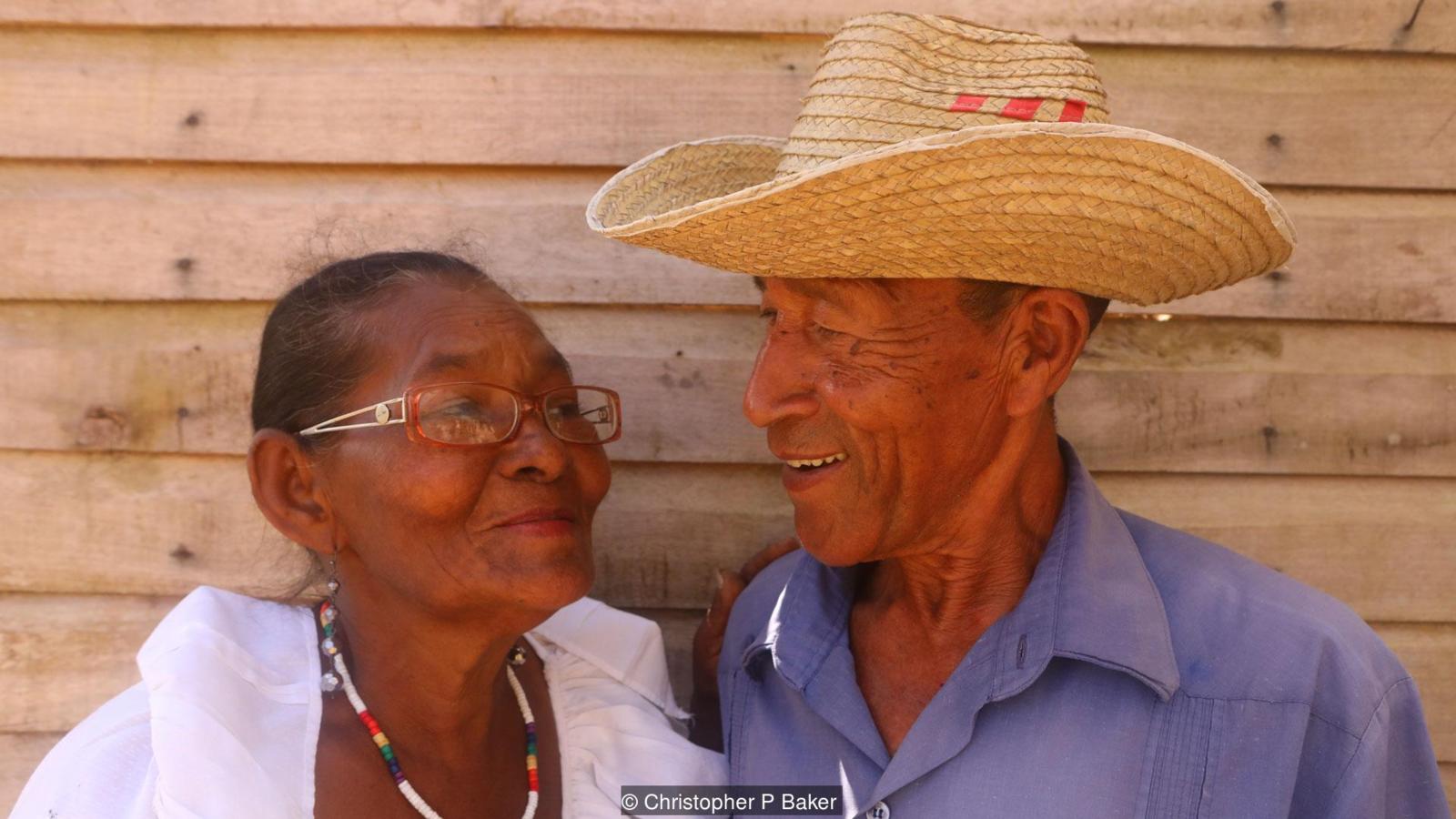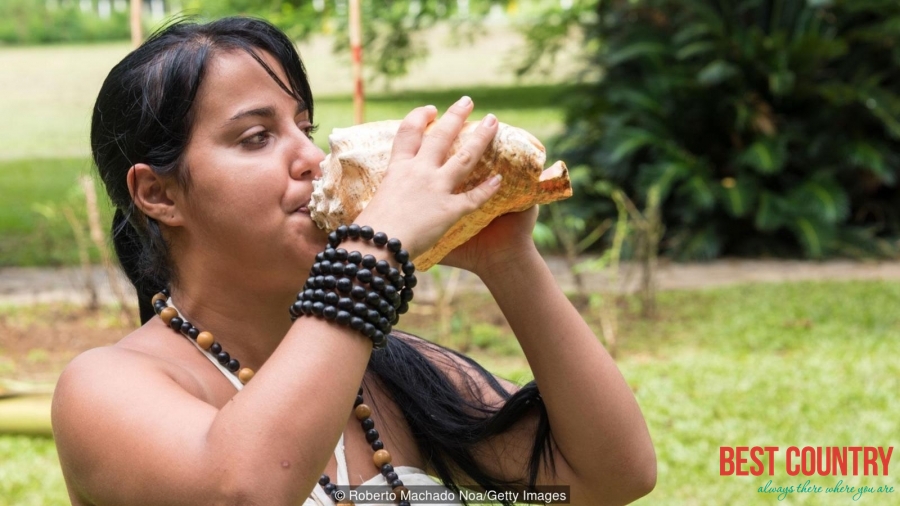Although it’s commonly believed that the indigenous Taíno were extirpated after Spanish conquest in 1511, their bloodlines, identity and customs were never completely extinguished.
A commonly repeated belief says that Cuba’s indigenous Taíno people were extirpated shortly after the Spanish conquest in 1511. Yet signs of living Taíno culture appear as my car bounces down the track to El Güirito, a remote hamlet at Cuba’s easternmost extreme that’s sandwiched between the azure Atlantic Ocean and surging mountain ranges smothered in throttling green.
It’s easy to see how pockets of indigenous people could survive in this wild, rugged place, passing down their genes through the centuries.
Arriving at El Güirito, I’m greeted by indios campesinos, humble farmers proud of their Indian heritage. Their coppery complexions, square jaws and prominent cheekbones – so distinct from elsewhere in Cuba – remind me of Amerindian faces I’ve seen in the Amazon.
Many rural Cuban families live in simple bohíos (thatched huts) with palm-plank walls. Yet nowhere else in Cuba have I seen graves topped by thatch and surrounded by guamo (conch) shells, preserving a Taíno superstition meant to thwart evil spirits. Nor still-smouldering plots of boniato (sweet potato), yucca and maize, newly cleared by slash-and-burn and heaped in earthen mounds, Taíno-style. Nor weathered campesinos prodding at the soil with coas, long, sharpened hoes that pre-date Columbus’ arrival in Cuba on 27 October 1492.
I’m as close as I’ll ever come to seeing the idyll Columbus saw on his first voyage to the New World.
 “[The indigenous people] show the most singular loving behaviour… and are gentle and always laughing,” Columbus recorded. Conquistador Diego Velázquez’s arrival in 1511 would change that forever. Those Taíno not put to the sword or worked to death fell victim to smallpox, influenza and measles, against which they had no defence. Within 100 years of Columbus’ landfall, virtually the entire indigenous population – heavily concentrated in the fertile lowlands of eastern Cuba – had perished.
“[The indigenous people] show the most singular loving behaviour… and are gentle and always laughing,” Columbus recorded. Conquistador Diego Velázquez’s arrival in 1511 would change that forever. Those Taíno not put to the sword or worked to death fell victim to smallpox, influenza and measles, against which they had no defence. Within 100 years of Columbus’ landfall, virtually the entire indigenous population – heavily concentrated in the fertile lowlands of eastern Cuba – had perished.
Yet contrary to popular claims, Taíno bloodlines, identity and customs were never completely extinguished.
Many survivors mixed with Spanish colonists or fled the flatlands to endure in palenques (hidden redoubts) in the rugged, densely forested mountains inland of Baracoa – an ancient Taíno village that, in 1511, became Cuba’s first Spanish colony. Encircled by a mountain meniscus unfurling like an abanico fan around the Bahía de Miel (Bay of Honey), this insular enclave wasn’t connected by road to the rest of Cuba until 1964.
Throughout the colonial period, Spanish authorities refused to acknowledge the existence of Taíno people. Yet 19th-Century records are full of references to caseríos (Indian kinship communities) in the mountains of eastern Oriente province. Even José Martí, revolutionary apostle of Cuban independence, recorded (in the days preceding his death in a Spanish ambush in May 1895) how he was tracked by the ‘indios de Garrido’ – Indian scouts from Yateras under the command of Spanish Lieutenant Pedro Garrido Romero.
As recently as the 1940s, Cuba’s preeminent geographer and anthropologist Antonio Nuñez Jiménez – who would later hold top positions in the Castro government – had documented dozens of caseríos scattered throughout the Sierra del Cristal and Macizo Nipe-Sagua-Baracoa mountains. Following the 1959 Cuban Revolution, however, the communist government vehemently promoted the notion of the Taíno’s extinction. It dissuaded distinct racial identification and instilled a singular mind set of ‘Cubanness’, intended to equalise everyone. “The government was drastic about it for years and didn’t want it to come up,” says José Barreiro, Cuban-American former director of the Office for Latin America at the Smithsonian National Museum of the American Indian, in a 2016 article for Smithsonian Magazine.
Not even Baracoa and its remote, rugged hinterland was spared the government’s gauche promotion of a singular ‘New Man’ mindset. “We families knew we were Indian, but as children we were told not to discuss it with other people,” said Rafael Cobas Romero, a member of El Gūirito’s Grupo Kiribá-Nengón, a cultural ensemble that keeps alive 19th-Century kiribá and nengón country music and dance forms that are rustic precursors to son, Cuba’s iconic traditional music (of Buena Vista Social Club fame).
Today the living Taíno identity is acknowledged, and no longer viewed as a challenge to cubanidad (Cuban identity). Instead, it’s promoted (albeit somewhat begrudgingly) as a touristic asset. Appropriately, I’ve brought my US motorcycle group to El Gūirito for a cultural ‘people-to-people’ encounter during our ride across Cuba (US embargo law states that US citizens traveling to Cuba for group travel may legally do so only for ‘people-to-people educational exchange’).
The ensemble strikes up, interpreting their traditional sounds with age-old Cuban instruments – the tambor (African drum), tres (Cuban guitar), claves (hardwood percussion sticks), güiro (gourd scraper), maracas, marimbula (plucked box), and a güayo scraper inherited from the Taíno serrated stone grating board used to shred yucca. Indios campesinos take our hands, kiss our cheeks and invite us to dance, showing us how to glide our feet across the floor like fish moving through water.
“Kiribá and nengón are rooted in our traditional guajiro(peasant) lifestyle. But our culinary traditions date back to the pre-Columbian era,” Teresa Roché Lore, the group’s director, explained.
Spread out before us is a buffet of uniquely baracoense dishes – distinctive from Cuba’s predictable pork, rice and beans – served Taíno-style in coconut shells and jícaras (hollowed gourds) or laid out on bateas (wooden trays). I savour spinach-like calalú simmered in leche de coco (coconut milk), and bacán, a steamed corn dough stuffed with plantain and pork, wrapped in blanched banana leaves. There’s lechita, shrimp in a well-seasoned coconut sauce, and a tiny opaque fish called tetí, fried then simmered in coconut milk with slivers of sweet peppers and onions. We end with delicious desserts, including yemitas, sweet balls of grated coconut and chocolate, and a chocolate drink called chorote made from coconut milk and cacao thickened with corn starch.
While many residents of El Gūirito display Amerindian features, Cuba’s Taíno descendants can’t always be identified by physical traits.
“You can be looking at a very Afro-Cuban or Iberian-looking person, but the DNA tells a different story,” Barreiro says in the article.
The government’s volte face echoes studies carried out in 2013 showing that Cuban blood is spiced with Taíno DNA, like ajiaco (a hearty Cuban stew of various meats, vegetables and tubers). The average proportion of Native American ancestry in the veins – 8% nationwide – climbs to 15% in eastern provinces (and far more in some individuals). It’s almost exclusively derived from maternal lineage, likely from the conquistadors brutal rape of Taíno women.
“There are no more pure-bloods, but I know many extended families of Indian heritage that still live in their aboriginal areas," said Baracoa’s historian, Alejandro Hartmann Matos, who has spent the past decade dedicated to rewriting the tale of the Taíno's demise. He estimates there are at least 4,000 Indo-Cubans who are biologically more Taíno than not.
“Many people in other communities have Taíno blood but won’t admit it. We don’t live exactly like our ancestors, but we’re proud of our heritage,” said Isolino Cobas Romero, a sun-beaten guajiro who leads the El Gūirito dance troupe.
 Taíno culture is most fully preserved in La Caridad de los Indios, a constellation of small caseríos of some 1,600 kin, nestled high in the lush Sierra del Cristal mountains overlooking Guantánamo. La Caridad de los Indios was the most remote palenque where Indian families settled after being ousted from their last lowland territory in 1850.
Taíno culture is most fully preserved in La Caridad de los Indios, a constellation of small caseríos of some 1,600 kin, nestled high in the lush Sierra del Cristal mountains overlooking Guantánamo. La Caridad de los Indios was the most remote palenque where Indian families settled after being ousted from their last lowland territory in 1850.
“There are Indians all over these mountains,” says 82-year-old Francisco ‘Panchito’ Ramírez Rojas, cacique (chief) of the Rojas-Ramírez clan, Cuba’s main Taíno extended family. Even Granma, Cuba’s official Communist Party newspaper, recently acknowledged the extended clan as living proof that the dictum of Taíno extinction is myth in an article titled Panchito, el último cacique (Panchito, the last chief).
The government’s acknowledgement of living Taíno culture owes much to the collapse of the Soviet Union in 1991. Cuba was suddenly critically short on food and medicine. In desperation, it turned to indigenous knowledge of traditional farming and natural medicines, shining a spotlight on a culture it had long denied.
“There are medicines all around us,” Panchito said, sweeping his arm in an arc. “The forest, this yard. They’re an entire pharmacy.”
The discovery that Cuba’s indigenous healers use scorpion stings to treat arthritis led Cuban scientists to ground-breaking cancer treatments. “We found that scorpion venom acts as an anti-inflammatory agent. It also stimulates the immune system and shrinks tumours,” explained Dr José Rodríguez Alonso, an Oxford-trained Cuban physician at Guantánamo’s Universidad de Ciencias Médicas.
Since the Cuban Revolution, most caseríos now have a clinic and school, and residential bungalows (many with solar panels) built by the State. But the community’s ways of life are infused with Taíno ceremonies, traditions and spiritual values common to many Native American cultures.
They fish tetí by the luna menquante (waning moon), and plant and harvest by the four lunar phases. They still pray to the sun, moon and Mother Earth. And they ask permission or forgiveness before harvesting or taking bark and leaves for cocimientos(healing remedies).
"The Spaniards killed most of us, but they left our roots,” Panchito said. “We mustn’t let this beautiful way that we have die.” He’s been passing on his knowledge to his children and grandchildren. But younger indios are leaving the mountains for a modern life in the cities. "Our race is disintegrating," he lamented wistfully.
But experiencing the ancestral rhythms and indigenous cuisine at El Gūirito – just 17km east of Baracoa – gives me hope. Watching Roché Lore and her kin guiding my group on the dance floor, I grasp how respectful visitation can be a viable way of helping keep alive traditional lifestyles by providing an income. Of investing indios campesinos in a future by giving touristic value to their past.
Burdened with the myth of extinction, most communities of Taíno descendants are still far off travellers’ radar. I’m inspired to take my next group into the mountains.
By Christopher P Baker (6 February 2019)